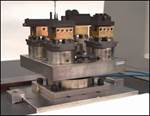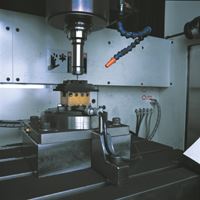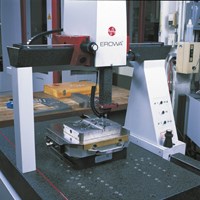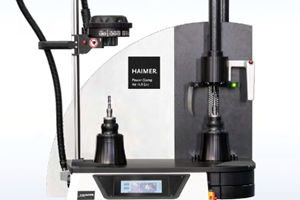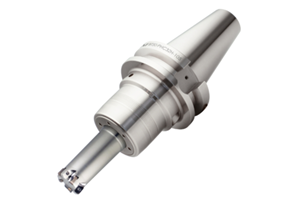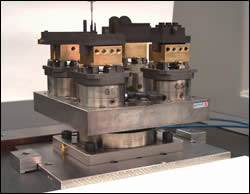Standardized Tooling and Automation Take the Lead Role
A moldmaker and its automation supplier team up to create a global competitor.
Founded in 1978 by the Ziegenhorn family, Matrix Tooling, Inc. (Wood Dale, IL) has prided itself on keeping the business in the family. Now, almost 24 years later, brothers Paul, Jim, Mark and Tom, along with John Sauber - vice-president and general manager - share the responsibilities of running the operation that consists of the design and contract manufacturing of multi-cavity injection molds. With its newly expanded facility of 30,000 square feet, Matrix has branched into plastic injection molding as well. In recent years, Matrix achieved ISO 9001 certification and provides a full set of services including mold design, mold building and qualification of molds and plastic molded parts. "Most of our markets are comprised of multi-cavity molds for a variety of consumer goods and electronic, medical and automotive products," says John Sauber. "We've truly become a global supplier with a significant amount of our molds being shipped not only to our U.S. customers, but also to their other manufacturing facilities including Mexico and the Pacific Rim." This globalization - coupled with customer needs - has driven the company's business. Superior consistency across entire sets of molds is critical, as parts from the molds are sent to facilities all over the world for final assembly.
Matrix, like many successful mold shops, has discovered that integrating engineering and manufacturing technologies is essential to maintaining quality while reducing product cycle times. "In the last few years, we've seen production times for a typical multi-cavity mold reduced from 12 weeks to eight - and sometimes to even as few as six weeks," notes Sauber. "What we did five years ago and what we do today, as far as precision and repeatability is concerned, has dramatically increased. This is why the philosophy of Erowa Technology's (Arlington Heights, IL) flexible machining concept has been so vital to meet these demands," he continues. This concept includes:
- The transfer of a workpiece from one machining operation to the next with .000080" repeatability.
- A workholding solution for almost every application, ranging from micro mechanics to some of the largest parts.
- A very flexible system that offers the ability to make your own pallets and custom fixtures by purchasing Erowa's centering elements.
Technology Makes the Difference
Matrix has moved into integrating its design and manufacturing software. By doing the mold design and manufacturing programming on the same system, there is no need to translate data on the shop floor. Once approved, the 3-D solids of the cavities, cores and electrodes are delivered directly to machining centers for graphite production and CNC sinker EDM'ing.
On the shop floor, Matrix quickly discovered the benefits of palletizing with Erowa. The ability to move a block from one machine to another without having to relocate the workpiece has resulted in more fully utilizing machine spindle time.
Matrix has been an Erowa user since 1991. At that time, a new Makino EDM came outfitted with the Erowa ITS system on the machine head. In addition, Erowa's Integrated Tooling System (ITS) also was installed on an existing VMC used for milling graphite electrodes. "We were cutting one electrode at a time," says Tom Ziegenhorn. "The next logical step was to put four chucks in that machine. So we bought another three ITS chucks and let it run for three times as long as we did before." Shortly thereafter, another mill was purchased and outfitted with four ITS chucks to increase graphite production.
Matrix reached the point that, in a 12-hour shift, it was cutting electrodes with almost no downtime. In addition to the mills, the company also had two sinker EDMs with Erowa toolchanging systems on them. While the Erowa tooling provided them with flexibility and repeatability across several machining operations, management at Matrix was looking for the next steps. "We were at a point now where we were re-evaluating everything and looking, obviously, at a robot for unattended machining that we knew would help us expand into the next level of automation," notes Ziegenhorn.
At the time, Matrix was a two-shift operation, where an operator would change electrodes after machining was complete. Ever-tightening delivery requirements forced Matrix to consider further automation to guarantee full use of a 24-hour day. At the same time, cost-reduction pressures also made them focus on automation. "Orders for multiple mold packages consisting of three of one mold and five of another mold at the same time lends itself to 'production-type' work," says Sauber. "We were familiar with Erowa's four-step concept and our comfort level with their products led us to start discussions with them and Makino to create an EDM cell."
Automating the Process
Initially, a couple of Erowa's proposals included the EasyChange robot that would increase productivity by simply changing the ITS pallets that Matrix had standardized. As the discussions progressed, Matrix quickly realized the benefits of Erowa's ERS System. "At first, we were thinking about getting one robot for one machine," notes Sauber. "But then we thought that since the robot is not going to be working 100 percent of the time when one EDM is running, why not put two EDMs on one robot? The fact that it was completely programmable gave us a lot of flexibility," Sauber continues. "It enabled us to integrate it into a cell with an existing Makino sinker and only have to purchase one new EDM." The cell consisting of the two Makino machines and the ERS Robot changes out not only workpieces, but also the electrodes on the EDMs. The multiple positions on the magazine and the flexibility of the ERS allow for small electrodes as well as palletized workpieces of more than 280 lbs.
A second ERS Robot was installed on a Makino SNC 64 to machine electrodes. With this system, unattended machining allows operators to feed these cells. Initially, Matrix had one graphite mill with four chucks. Now, the Makino is equipped with one ITS chuck and a second ERS Robot holding 80 electrodes in the magazine. "It's really efficient," states Ziegenhorn. "You now have a machine that is capable of running 24 hours a day."
Setup of the mills is highly automated. While the ERS robot loads the electrodes, the VMC does not know the height of that electrode. The machine tool is programmed to control a Renishaw probe to automatically measure the piece. This data is then fed back to the control. Since the machine now knows the "Z" height, it can start the operation. In a similar manner, a laser inside the machine not only measures the diameter, but also checks the cutting tool for wear.
Increased Machine Utilization Through Presetting "The ERS System really was a no-brainer, once you saw the benefits of establishing a cell with a robot serving two EDMs," Sauber adds. With the cell's 24/7 capabilities, it quickly became apparent to Matrix that doing setups on the machine tool was detracting from maximizing machine utilization. "We added an Erowa PreSet 3D station so operators can do the setup and measuring of the electrodes, as well as the setup and measuring of the workpieces off-line," said Sauber. "By doing all of our programming and setup off-line ahead of time, we just load workpieces and keep going."
With the addition of the PreSet 3D coupled with the Erowa ITS tooling, electrodes and workpieces move from operation to operation, and measurement and inspection occur with repeatable 0.000080" accuracy. "With one offset common to all of the machines across the shop, productivity and efficiency have definitely increased," states Sauber. "As far as the guys who do setup in EDM, they are now more involved with transferring the offset information from the programmer or the CAD/CAM system. So, we're not doing a lot of button pushing."
Through the presetting operation, offset data from the workpieces as well as the electrodes are posted and sent to the EDM via a RS-232 Interface. All of the offsets get stored for future jobs. "We see the benefits of also now taking our three other EDMs that just have magnets in them and putting in the same type of palletization system that we have in the automatic machines," says Sauber. "Even though these are machines without drop tanks - and we won't automate them with robots - with the presetting station, we can send the data to the other CNC machines. With palletization, we still get the benefits as far as the off-line presetting," Sauber concludes.
The Future Is Now
Matrix has experienced significant productivity increases in both the EDM cell and the automation of graphite milling. "I would say that we are seeing an increased utilization of 70 percent in both the graphite milling and EDM'ing operations," says Sauber. For Matrix, it comes down to planning and scheduling the workday. "A big thing is the human factor," notes Sauber. "The operators, moldmakers and programmers have got to learn to plan their days so that when it gets to be close to 4:00 and they're leaving at 5:00, they've got something ready to go. In our operations training, we stress that maybe three hours of that day need to be spent on planning what jobs will be run overnight. The key to Matrix's automation is developing that mindset and it's the people that have to drive that."
Matrix plans to continue developing its multi-cavity niche as well as expanding its injection molding capabilities. With a commitment to capital purchases and technology, Sauber notes that additional automation would follow with the growth of the company. "We'll definitely consider Erowa robots on future machine purchases," he says. "Unlike other dedicated automation components we looked at, Erowa's programmability provides us the flexibility to move them to a completely different operation, should we choose."
Related Content
Shrink-Fit Machine Features Integrated Cooling
Power Clamp Air i4.0 Eco by Haimer USA provides smooth and clean cooling of all kinds of toolholders or collets by air, without dirt and water residue.
Read MoreCNC Platform Creates Adaptable Interface for Workholding
IMTS 2024: Features such as advanced collision protection and greater operational functionality make Heidenhain’s TNC7 CNC control platform critical for mold builders, who often face multi-surface machining.
Read More2024 Moldmaking Insights: A Year in Review Part 1
A look back at the top moldmaking trends of 2024, as revealed through MMT's analytics. This review highlights the most popular technical articles, case studies, tips and best practices that captured the industry's attention over the past year.
Read MoreHydro Chuck Toolholder Promises Precision When Heavy Milling
Precision cutting tool solutions manufacturer NT Tool presents Hydro Chuck Omega, designed to eliminate the common issues of chatter, deflection and pullout.
Read MoreRead Next
Standardize Before You Automate
After standardization, automation will create the largest increase in profits that any one area can produce.
Read MoreAre You a Moldmaker Considering 3D Printing? Consider the 3D Printing Workshop at NPE2024
Presentations will cover 3D printing for mold tooling, material innovation, product development, bridge production and full-scale, high-volume additive manufacturing.
Read MoreHow to Use Continuing Education to Remain Competitive in Moldmaking
Continued training helps moldmakers make tooling decisions and properly use the latest cutting tool to efficiently machine high-quality molds.
Read More
